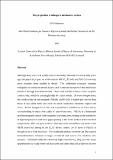The properties of ultrapure delafossite metals
Abstract
Although they were first synthesized in chemistry laboratories nearly fifty years ago, the physical properties of the metals PdCoO2, PtCoO2 and PdCrO2 have only more recently been studied in detail. The delafossite structure contains triangular co-ordinated atomic layers, and electrical transport in the delafossite metals is strongly two-dimensional. Their most notable feature is their in-plane conductivity, which is amazingly high for oxide metals. At room temperature, the conductivity of non-magnetic PdCoO2 and PtCoO2 is higher per carrier than those of any alkali metal and even the most conductive elements, copper and silver. At low temperatures the best crystals have resistivities of a few nΩ cm, corresponding to mean free paths of tens of microns. PdCrO2 is a frustrated antiferromagnetic metal, with magnetic scattering contributing to the resistivity at high temperatures and small gaps opening in the Fermi surface below the Néel temperature. There is good evidence that electronic correlations are weak in the Pd/Pt layers but strong in the Co/Cr layers; indeed the Cr layer in PdCrO2 is thought to be a Mott insulator. The delafossite metals therefore act like natural heterostructures between strongly correlated and nearly free electron subsystems. Combined with the extremely high conductivity, they provide many opportunities to study electrical transport and other physical properties in new regimes. The purpose of this review is to describe current knowledge of these fascinating materials and set the scene for what is likely to be a considerable amount of future research.
Citation
Mackenzie , A P 2017 , ' The properties of ultrapure delafossite metals ' , Reports on Progress in Physics , vol. 80 , no. 3 , 032501 . https://doi.org/10.1088/1361-6633/aa50e5
Publication
Reports on Progress in Physics
Status
Peer reviewed
ISSN
0034-4885Type
Journal item
Collections
Items in the St Andrews Research Repository are protected by copyright, with all rights reserved, unless otherwise indicated.

